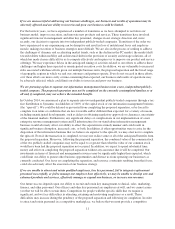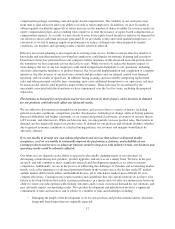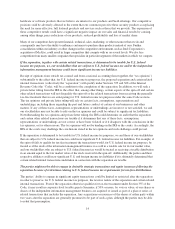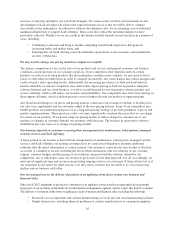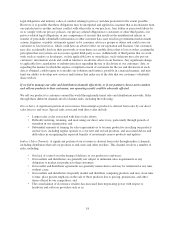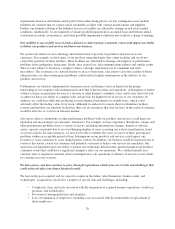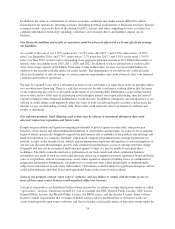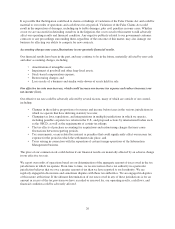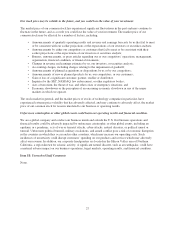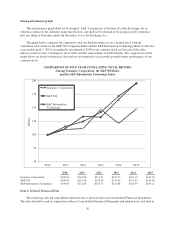Symantec 2015 Annual Report Download - page 99
Download and view the complete annual report
Please find page 99 of the 2015 Symantec annual report below. You can navigate through the pages in the report by either clicking on the pages listed below, or by using the keyword search tool below to find specific information within the annual report.• Assumption of liabilities of the acquired business, including litigation related to the acquired business;
• The addition of acquisition-related debt as well as increased expenses and working capital
requirements;
• Dilution of stock ownership of existing stockholders; and
• Substantial accounting charges for restructuring and related expenses, write-off of in-process research
and development, impairment of goodwill, amortization of intangible assets, and stock-based
compensation expense.
If integration of our acquired businesses is not successful, we may not realize the potential benefits of an
acquisition or suffer other adverse effects. To integrate acquired businesses, we must implement our technology
systems in the acquired operations and integrate and manage the personnel of the acquired operations. We also
must effectively integrate the different cultures of acquired business organizations into our own in a way that
aligns various interests, and may need to enter new markets in which we have no or limited experience and where
competitors in such markets have stronger market positions.
Any of the foregoing, and other factors, could harm our ability to achieve anticipated levels of profitability from
our acquired businesses or to realize other anticipated benefits of acquisitions.
Our international operations involve risks that could increase our expenses, adversely affect our operating
results, and require increased time and attention of our management.
We derive a substantial portion of our revenues from customers located outside of the U.S. and we have
significant operations outside of the U.S., including engineering, sales, customer support, and production. We
plan to expand our international operations, but such expansion is contingent upon our identification of growth
opportunities. Our international operations are subject to risks in addition to those faced by our domestic
operations, including:
• Potential loss of proprietary information due to misappropriation or laws that may be less protective of
our intellectual property rights than U.S. laws or that may not be adequately enforced;
• Requirements of foreign laws and other governmental controls, including trade and labor restrictions
and related laws that reduce the flexibility of our business operations;
• Regulations or restrictions on the use, import, or export of encryption technologies that could delay or
prevent the acceptance and use of encryption products and public networks for secure communications;
• Local business and cultural factors that differ from our normal standards and practices, including
business practices that we are prohibited from engaging in by the Foreign Corrupt Practices Act and
other anti-corruption laws and regulations;
• Central bank and other restrictions on our ability to repatriate cash from our international subsidiaries
or to exchange cash in international subsidiaries into cash available for use in the U.S.;
• Fluctuations in currency exchange rates, economic instability and inflationary conditions could reduce
our customers’ ability to obtain financing for software products or could make our products more
expensive or could increase our costs of doing business in certain countries;
• Limitations on future growth or inability to maintain current levels of revenues from international sales
if we do not invest sufficiently in our international operations;
• Longer payment cycles for sales in foreign countries and difficulties in collecting accounts receivable;
• Difficulties in staffing, managing, and operating our international operations, including difficulties
related to administering our stock plans in some foreign countries;
• Difficulties in coordinating the activities of our geographically dispersed and culturally diverse
operations;
• Seasonal reductions in business activity in the summer months in Europe and in other periods in other
countries;
• Costs and delays associated with developing software and providing support in multiple languages; and
• Political unrest, war, or terrorism, or regional natural disasters, particularly in areas in which we have
facilities.
21


